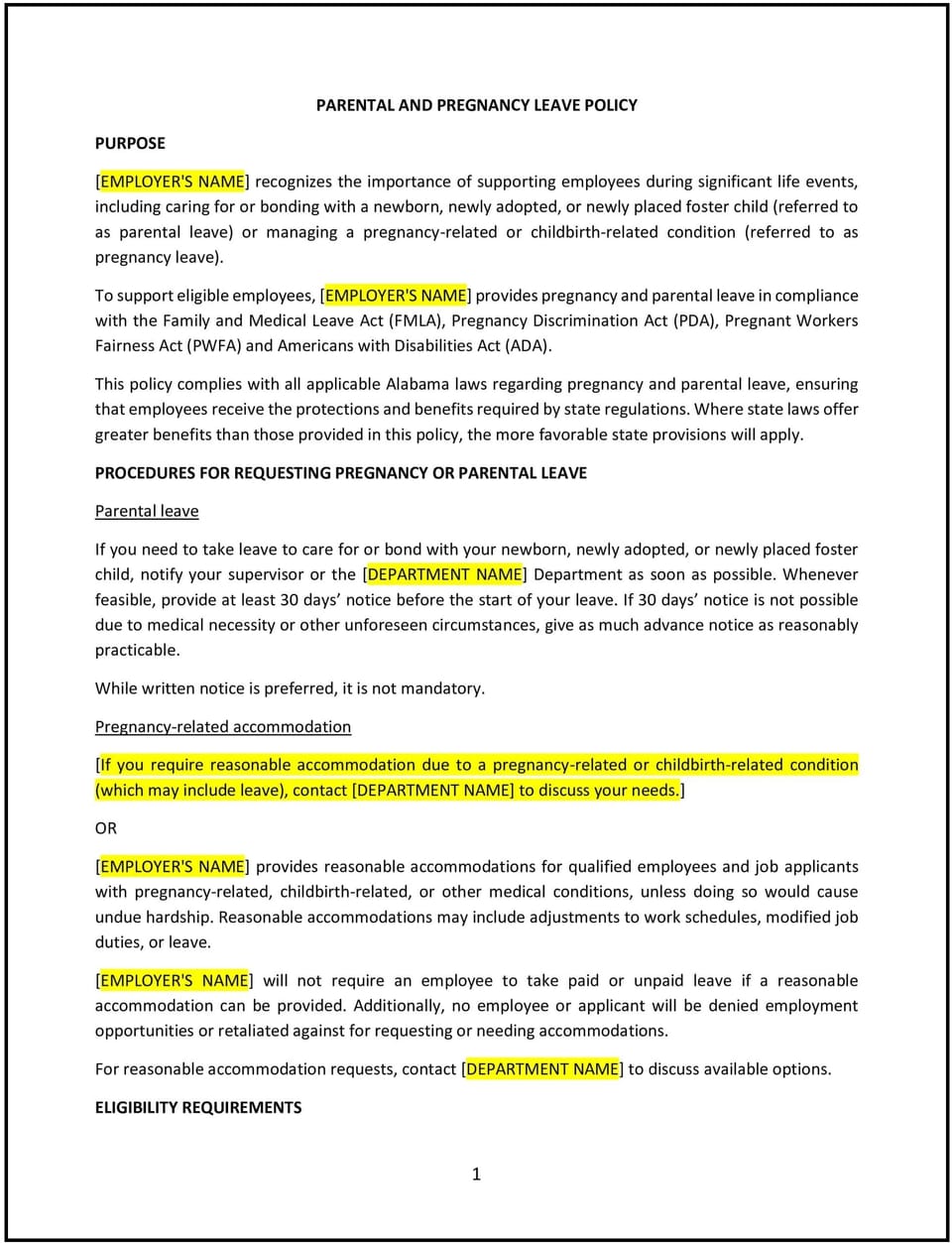Parental and pregnancy leave policy (Alabama): Free template

Parental and pregnancy leave policy (Alabama)
A parental and pregnancy leave policy provides employees with clear guidelines on taking leave for childbirth, adoption, or pregnancy-related medical needs. For SMBs in Alabama, this policy ensures employees understand their rights and responsibilities while allowing businesses to plan for temporary absences.
By outlining eligibility, leave duration, and procedures, this policy fosters a supportive work environment and promotes compliance with applicable state and federal regulations, such as the Family and Medical Leave Act (FMLA).
How to use this parental and pregnancy leave policy (Alabama)
- Define eligibility: Clearly outline the requirements for employees to qualify for parental or pregnancy leave, such as length of employment or hours worked.
- Specify leave duration: Detail the amount of leave available, distinguishing between unpaid leave under FMLA and any paid leave options provided by the company.
- Address medical needs: Include provisions for pregnancy-related medical leave, such as time off for prenatal appointments or recovery from childbirth.
- Provide request procedures: Explain how employees should apply for leave, including notice periods, documentation, and medical certifications if applicable.
- Highlight job protection: Reaffirm employees’ rights to return to the same or an equivalent position after their leave period.
Benefits of using a parental and pregnancy leave policy (Alabama)
A parental and pregnancy leave policy benefits your business by supporting employees and ensuring consistency. Here’s how it helps:
- Encourages work-life balance: Demonstrates the company’s commitment to supporting employees during important life events.
- Ensures compliance: Aligns with state and federal laws, reducing risks of legal issues related to leave entitlements.
- Promotes employee retention: Fosters loyalty and morale by providing clear and supportive leave options.
- Simplifies planning: Helps managers and HR coordinate resources and temporary coverage for employees on leave.
- Enhances company reputation: Reflects positively on the organization’s culture and commitment to employee well-being.
Tips for implementing a parental and pregnancy leave policy (Alabama)
- Communicate clearly: Include this policy in employee handbooks and provide regular updates during onboarding and team meetings.
- Train managers: Ensure supervisors understand their role in supporting employees and enforcing the policy fairly.
- Offer flexibility: Where possible, allow employees to extend leave using PTO, unpaid leave, or other arrangements to accommodate their needs.
- Maintain confidentiality: Handle leave requests and related discussions discreetly to protect employees’ privacy.
- Review regularly: Update the policy to reflect changes in laws or company practices and address feedback from employees.
Q: Who is eligible for parental and pregnancy leave under this policy?
A: Eligibility typically includes employees who have worked for the company for at least 12 months and meet minimum hours worked requirements, as outlined by FMLA.
Q: Is parental leave paid or unpaid?
A: Parental leave is typically unpaid under FMLA, but the company may offer paid leave options or allow employees to use accrued PTO or sick leave.
Q: What documentation is required for leave requests?
A: Employees may need to provide a doctor’s note, medical certification, or proof of adoption to confirm eligibility and leave duration.
Q: How much notice should employees give before taking leave?
A: Employees should provide at least 30 days’ notice for foreseeable leave or as much notice as possible for unplanned circumstances.
Q: Are employees guaranteed their job after returning from leave?
A: Yes, employees are generally entitled to return to the same or an equivalent position, as required by FMLA and company policy.
Q: Can both parents take leave under this policy?
A: If both parents are employees of the company, leave may be split or taken concurrently, depending on company guidelines and legal requirements.
This article contains general legal information and does not contain legal advice. Cobrief is not a law firm or a substitute for an attorney or law firm. The law is complex and changes often. For legal advice, please ask a lawyer.


